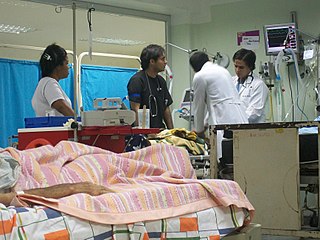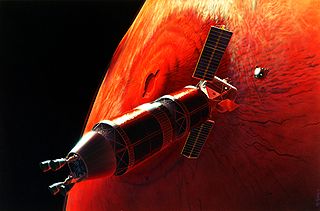Related Research Articles

Interplanetary spaceflight or interplanetary travel is the crewed or uncrewed travel between stars and planets, usually within a single planetary system. In practice, spaceflights of this type are confined to travel between the planets of the Solar System. Uncrewed space probes have flown to all the observed planets in the Solar System as well as to dwarf planets Pluto and Ceres, and several asteroids. Orbiters and landers return more information than fly-by missions. Crewed flights have landed on the Moon and have been planned, from time to time, for Mars, Venus and Mercury. While many scientists appreciate the knowledge value that uncrewed flights provide, the value of crewed missions is more controversial. Science fiction writers propose a number of benefits, including the mining of asteroids, access to solar power, and room for colonization in the event of an Earth catastrophe.

Mars Direct is a proposal for a human mission to Mars which purports to be both cost-effective and possible with current technology. It was originally detailed in a research paper by Martin Marietta engineers Robert Zubrin and David Baker in 1990, and later expanded upon in Zubrin's 1996 book The Case for Mars. It now serves as a staple of Zubrin's speaking engagements and general advocacy as head of the Mars Society, an organization devoted to the colonization of Mars.

Space colonization is the process of establishing human settlements beyond Earth for prestige, commercial or strategic benefit, in contrast to space exploration for scientific benefit. Colonialism in this sense is multi-dimensional, including the exploitation of labor, resources and rights.

Hibernation is a state of minimal activity and metabolic depression undergone by some animal species. Hibernation is a seasonal heterothermy characterized by low body-temperature, slow breathing and heart-rate, and low metabolic rate. It is most commonly used to pass through winter months – called overwintering.
A sleeper ship is a hypothetical type of crewed spacecraft, or starship in which most or all of the crew spend the journey in some form of hibernation or suspended animation. The only known technology that allows long-term suspended animation of humans is the freezing of early-stage human embryos through embryo cryopreservation, which is behind the concept of embryo space colonization.

Suspended animation is the temporary slowing or stopping of biological function so that physiological capabilities are preserved. States of suspended animation are common in micro-organisms and some plant tissue, such as seeds. Many animals, including large ones, may undergo hibernation, and most plants have periods of dormancy. This article focuses primarily on the potential of large animals, especially humans, to undergo suspended animation.

Torpor is a state of decreased physiological activity in an animal, usually marked by a reduced body temperature and metabolic rate. Torpor enables animals to survive periods of reduced food availability. The term "torpor" can refer to the time a hibernator spends at low body temperature, lasting days to weeks, or it can refer to a period of low body temperature and metabolism lasting less than 24 hours, as in "daily torpor".

The Constellation program was a crewed spaceflight program developed by NASA, the space agency of the United States, from 2005 to 2009. The major goals of the program were "completion of the International Space Station" and a "return to the Moon no later than 2020" with a crewed flight to the planet Mars as the ultimate goal. The program's logo reflected the three stages of the program: the Earth (ISS), the Moon, and finally Mars—while the Mars goal also found expression in the name given to the program's booster rockets: Ares. The technological aims of the program included the regaining of significant astronaut experience beyond low Earth orbit and the development of technologies necessary to enable sustained human presence on other planetary bodies.

The colonization of Mars is the proposed process of establishing and maintaining control of Martian land for exploitation and the possible settlement of Mars. Most colonization concepts focus on settling, but colonization is a broader ethical concept, which international space law has limited, and national space programs have avoided, instead focusing on human mission to Mars for exploring the planet. The settlement of Mars would require the migration of humans to the planet, the establishment of a permanent human presence, and the exploitation of local resources.
The Ride Report is the informal name of the report titled NASA Leadership and America's Future in Space: A Report to the Administrator. In 1986, a task force under the leadership of Sally Ride was asked to formulate a new strategy for NASA. The report was issued in 1987.

The NASA Innovative Advanced Concepts (NIAC) is a NASA program for development of far reaching, long term advanced concepts by "creating breakthroughs, radically better or entirely new aerospace concepts". It funds work on revolutionary aeronautics and space concepts that can dramatically impact how NASA develops and conducts its missions. The program operated under the name NASA Institute for Advanced Concepts from 1998 until 2007, and was reestablished in 2011 under the name NASA Innovative Advanced Concepts and continues to the present.

NASA Design Reference Mission 3.0 was a NASA study for a human space mission to the planet Mars in the 1990s. It was a plan for a human exploration architecture for Mars, and was released in 1998 as an addendum to the early design plans released in 1994. The plan is for a series of multiple launches to send various space transpiration, surface exploration hardware, and human crew to Mars, and to return the crew to Earth in the early 21st century. Various technologies are explored to launch the payloads into space, to send them to Mars, and to reduce overall weight of the mission by various technologies or techniques including nuclear, solar, aerobraking, and in-situ resource use.

The idea of sending humans to Mars has been the subject of aerospace engineering and scientific studies since the late 1940s as part of the broader exploration of Mars. Long-term proposals have included sending settlers and terraforming the planet. Currently, only robotic landers and rovers have been on Mars. The farthest humans have been beyond Earth is the Moon, under the U.S. National Aeronautics and Space Administration (NASA) Apollo program which ended in 1972.

Mars orbit rendezvous (MOR) is a space travel concept where two spacecraft meet up and/or dock in Mars orbit.

Mars to Stay missions propose that astronauts sent to Mars for the first time should intend to remain there. Unused emergency return vehicles would be recycled into settlement construction as soon as the habitability of Mars becomes evident to the initial pioneers. Mars to Stay missions are advocated both to reduce cost and to ensure permanent settlement of Mars. Among many notable Mars to Stay advocates, former Apollo astronaut Buzz Aldrin has been particularly outspoken, suggesting in numerous forums "Forget the Moon, Let’s Head to Mars!" and, in June 2013, Aldrin promoted a crewed mission "to homestead Mars and become a two-planet species". In August 2015, Aldrin, in association with the Florida Institute of Technology, presented a "master plan", for NASA consideration, for astronauts, with a "tour of duty of ten years", to colonize Mars before the year 2040. The Mars Underground, Mars Homestead Project / Mars Foundation, Mars One, and Mars Artists Community advocacy groups and business organizations have also adopted Mars to Stay policy initiatives.
SpaceWorks Enterprises, Inc. (SEI) is an aerospace engineering company based in Atlanta, Georgia, United States that specializes in the design, assessment, hardware prototyping and flight demonstration of advanced space concepts for both government and commercial customers.

Inspiration Mars Foundation was an American nonprofit organization founded by Dennis Tito that in 2013 proposed to launch a crewed mission to flyby Mars in January 2018, or 2021 if they missed the first synodic opportunity in 2018.

The Asteroid Redirect Mission (ARM), also known as the Asteroid Retrieval and Utilization (ARU) mission and the Asteroid Initiative, was a space mission proposed by NASA in 2013; the mission was later cancelled. The Asteroid Retrieval Robotic Mission (ARRM) spacecraft would rendezvous with a large near-Earth asteroid and use robotic arms with anchoring grippers to retrieve a 4-meter boulder from the asteroid.

SpaceX Mars colonization program is a planned objective of the company SpaceX and particularly of its founder Elon Musk to colonize Mars. The main element of this ambition is the plan to establish a self-sustained large scale settlement and colony on Mars, claiming self-determination under direct democracy. The main motivation behind this is the belief that the colonization of Mars allows humanity to become multiplanetary and therefore secures the long-term survival of the human species in case of Earth being rid of human life.

A Mars habitat is a hypothetical place where humans could live on Mars. Mars habitats would have to contend with surface conditions that include almost no oxygen in the air, extreme cold, low pressure, and high radiation. Alternatively, the habitat might be placed underground, which helps solve some problems but creates new difficulties.
References
- ↑ Hall, Loura (2016-04-14). "Torpor Inducing Transfer Habitat For Human Stasis To Mars". NASA. Retrieved 2020-12-15.
- ↑ "Enter Sandman: Hibernation Technologies for Deep-Space Missions". interestingengineering.com. 2019-12-11. Retrieved 2020-12-15.